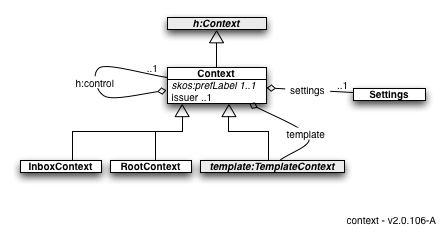Notice: this Wiki will be going read only early in 2024 and edits will no longer be possible. Please see: https://gitlab.eclipse.org/eclipsefdn/helpdesk/-/wikis/Wiki-shutdown-plan for the plan.
Context vocabulary
{{#eclipseproject:technology.higgins|eclipse_custom_style.css}}
A vocabulary to describe contexts. Imported by Persona vocabulary.
Contents
Files
- SVN source: context.owl
UML Overview
Classes
Context
A context as used in the Persona data model
- subClassOf: h:Context
- 0..1 h:control
- 0..1 issuer
- 0..1 template
- 0..1 settings
- 1..1 skos:prefLabel
issuer
The entity (e.g. a business, bank, government agency, person, social network) that defines this context: defines the vocabulary used, defines the meaning of the attributes of the vocabulary, defines the interaction context withing which these attributes gain values. The issuer is often, but not necessarily the entity that makes the attribute value assertions (claims). If the issuer is Equifax, then indeed Equifax is making the claim that the "bearer" of this context is, say, over 21 years of age. As a counter example, the issuer of a context might be Facebook. In this case the values are asserted by the Facebook user, yet Facebook is considered the issuer. If the issuer is not present, then this is a self-asserted context--the user is the issuer.
- domain: Context
- value: xsd:anyURI
RootContext
A tagging subclass indicating that this context is the "root" context for this user. There should only be one instance of RootContext for each user.
- subClassOf: Context
Settings
A class to hold setting information for the containing context. Settings are the user's preferences for how to interact with the containing context, as opposed to pure data held by the context. It is expected that contexts that have specific settings will attach them as attributes to an instance of Settings (or some subclass thereof).
- subClassOf: owl:Thing
Attributes
issuer
The entity (e.g. a business) that defines this context: defines the schema used, defines the meaning of the attributes of the schema, defines the interaction context withing which these attributes gain values. The issuer is often, but not necessarily the entity that makes the attribute value assertions (claims). If the issuer is Equifax, then indeed Equifax is making the claim that the "bearer" of this context is, say, over 21 years of age. As a counter example, the issuer of a context might be Facebook. In this case the values are asserted by the Facebook user, yet Facebook is considered the issuer. This is a required attribute of all Contexts.
- domain: Context
- value: URI. The URI is either the domain name that is the authority behind the attribute assertions or
- The value
http://!self- the user has explicitly asserted entities & attributes in this context - The value
http://!derived- the active client has derived entities & attributes in this context based on observed behavior and/or assertions made by the user in other contexts
- The value
settings
A singleton instance of the Settings class.
- domain: Context
- value: Settings
template
A link to a TemplateContext that acts as a template for this context.
- domain: Context
- value: template:TemplateContext
Attributes from higgins.owl
Repeated here for convenience.
h:control
Inherited from h:Context. See Higgins Data Model 2.0.
- domain: Context
- value: h:Context
h:vocabulary
Inherited from h:Context. See Higgins Data Model 2.0.
- domain: h:Context
- range: owl:Ontology

